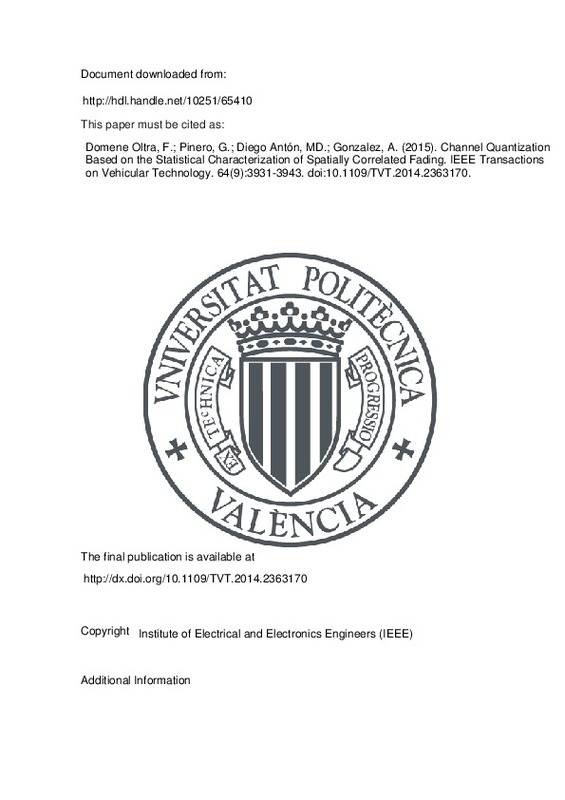JavaScript is disabled for your browser. Some features of this site may not work without it.
Buscar en RiuNet
Listar
Mi cuenta
Estadísticas
Ayuda RiuNet
Admin. UPV
Channel Quantization Based on the Statistical Characterization of Spatially Correlated Fading
Mostrar el registro sencillo del ítem
Ficheros en el ítem
| dc.contributor.author | Domene Oltra, Fernando
|
es_ES |
| dc.contributor.author | Piñero Sipán, María Gemma
|
es_ES |
| dc.contributor.author | Diego Antón, María de
|
es_ES |
| dc.contributor.author | Gonzalez, Alberto
|
es_ES |
| dc.date.accessioned | 2016-06-07T11:47:45Z | |
| dc.date.available | 2016-06-07T11:47:45Z | |
| dc.date.issued | 2015-09 | |
| dc.identifier.issn | 0018-9545 | |
| dc.identifier.uri | http://hdl.handle.net/10251/65410 | |
| dc.description.abstract | Multiuser multiple-input-multiple-output (MUMIMO) techniques, such as scheduling and precoding, have shown to improve the spectral efficiency of wireless communication systems. However, these techniques require an accurate knowledge of the channel of the different users at the transmitter. In frequency-division duplex (FDD) systems, this information has to be provided by the different users, motivating the research of efficient limited feedback schemes. This paper presents a novel statistical characterization of the spatial multiple-input-single-output (MISO) channel. In this characterization, one antenna is selected as the reference, and the channel fading experienced from this antenna is also considered to be the reference. The conditional probability density functions (CPDFs) of the envelope and phase of the channel fading coefficients from the rest of the antennas (denoted as nonreference channel fading and nonreference antennas) are obtained given the reference one. Based on this statistical characterization, this paper proposes a channel quantization scheme that individually quantizes the channel fading coefficient of each transmit antenna that is seen by each user. The envelope and phase of the reference channel fading are quantized considering a Rayleigh distribution and a uniform distribution, respectively. The nonreference channel fading coefficients are quantized according to their respective CPDFs, which in turn depend on the spatial correlation between each channel fading and the reference channel fading. Numerical simulations have been carried out to compare the performance of the proposed conditional quantization (CQ) scheme with a polar quantization (PQ) and with a quantization based on the Karhunen-Loève (KL) transform. PQ does not consider spatial correlation, CQ needs one spatial correlation coefficient per nonreference antenna, and the KL scheme makes use of the full spatial correlation matrix. The results show that CQ achieves a lower quantization mean square error (MSE) than the other two schemes in highly and moderately correlated environments. When the spatial channel model (SCM) is considered, the proposed scheme allows the spatial correlation to be successfully exploited in arrays with N=hbox4 and N=hbox8 transmit antennas for antenna separations that are lower than d=hbox1.3lambda and d=hbox0.75lambda, respectively | es_ES |
| dc.description.sponsorship | This work was supported by European Union ERDF and Spanish Government through Project TEC2012-38142-C04 and Generalitat Valenciana through Project PROME-TEOII/2014/003. | en_EN |
| dc.language | Inglés | es_ES |
| dc.publisher | Institute of Electrical and Electronics Engineers (IEEE) | es_ES |
| dc.relation.ispartof | IEEE Transactions on Vehicular Technology | es_ES |
| dc.rights | Reserva de todos los derechos | es_ES |
| dc.subject | Communication channels | es_ES |
| dc.subject | Fading channels | es_ES |
| dc.subject | MIMO systems | es_ES |
| dc.subject | Wireless telecommunication systems | es_ES |
| dc.subject | Frequency division duplex system | es_ES |
| dc.subject | Full spatial correlation matrix | es_ES |
| dc.subject.classification | TEORIA DE LA SEÑAL Y COMUNICACIONES | es_ES |
| dc.title | Channel Quantization Based on the Statistical Characterization of Spatially Correlated Fading | es_ES |
| dc.type | Artículo | es_ES |
| dc.identifier.doi | 10.1109/TVT.2014.2363170 | |
| dc.relation.projectID | info:eu-repo/grantAgreement/MINECO//TEC2012-38142-C04-01/ES/PROCESADO DISTRIBUIDO Y COLABORATIVO DE SEÑALES SONORAS: CONTROL ACTIVO/ | es_ES |
| dc.relation.projectID | info:eu-repo/grantAgreement/GVA//PROMETEOII%2F2014%2F003/ES/Computación y comunicaciones de altas prestaciones y aplicaciones en ingeniería/ | es_ES |
| dc.rights.accessRights | Abierto | es_ES |
| dc.contributor.affiliation | Universitat Politècnica de València. Departamento de Comunicaciones - Departament de Comunicacions | es_ES |
| dc.contributor.affiliation | Universitat Politècnica de València. Instituto Universitario de Telecomunicación y Aplicaciones Multimedia - Institut Universitari de Telecomunicacions i Aplicacions Multimèdia | es_ES |
| dc.description.bibliographicCitation | Domene Oltra, F.; Piñero Sipán, MG.; Diego Antón, MD.; Gonzalez, A. (2015). Channel Quantization Based on the Statistical Characterization of Spatially Correlated Fading. IEEE Transactions on Vehicular Technology. 64(9):3931-3943. https://doi.org/10.1109/TVT.2014.2363170 | es_ES |
| dc.description.accrualMethod | S | es_ES |
| dc.relation.publisherversion | http://dx.doi.org/10.1109/TVT.2014.2363170 | es_ES |
| dc.description.upvformatpinicio | 3931 | es_ES |
| dc.description.upvformatpfin | 3943 | es_ES |
| dc.type.version | info:eu-repo/semantics/publishedVersion | es_ES |
| dc.description.volume | 64 | es_ES |
| dc.description.issue | 9 | es_ES |
| dc.relation.senia | 297054 | es_ES |
| dc.contributor.funder | Generalitat Valenciana | es_ES |
| dc.contributor.funder | Ministerio de Economía y Competitividad | es_ES |
| dc.contributor.funder | European Regional Development Fund | es_ES |







![[Cerrado]](/themes/UPV/images/candado.png)

